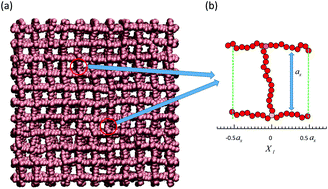A potential barrier in the diffusion of nanoparticles in ordered polymer networks†
Abstract
Diffusion of nanoparticles (NPs) in a polymer matrix is of significant importance in diverse research fields, such as bio-engineering and nano-technology. Although the prediction of the effective diffusivity has been extensively explored, it remains a great challenge for theoretical investigation. In the present study, the single-particle Dissipative Particle Dynamics (DPD) is employed to study the diffusion of nanoparticles in an unentangled ordered polymer network. To explore the main mechanism of the diffusion of nanoparticles, detailed microscopic information of the interaction between the polymer and nanoparticles is analyzed, in which the deformation of the network due to crosslink deviation induced by nanoparticle squeezing is observed, and the failed hopping or bounce-back of a nanoparticle can be identified based on its trajectories. It is suggested that, besides the potential well trapping the NPs due to the network, an additional energy induced by the deformation of the local structure of the polymer network during failed hopping should be included in constructing the potential barrier. Then the Nonlinear Langevin equation (NLE) and Kramer's theory are utilized to predict the effective diffusivity DL using the modified potential well. It is found that the theoretical prediction of diffusivity based on this idea is in good agreement with the simulation results of DPD. This study might be helpful for extending our understanding of the diffusion of nanoparticles in complex environments.



 Please wait while we load your content...
Please wait while we load your content...